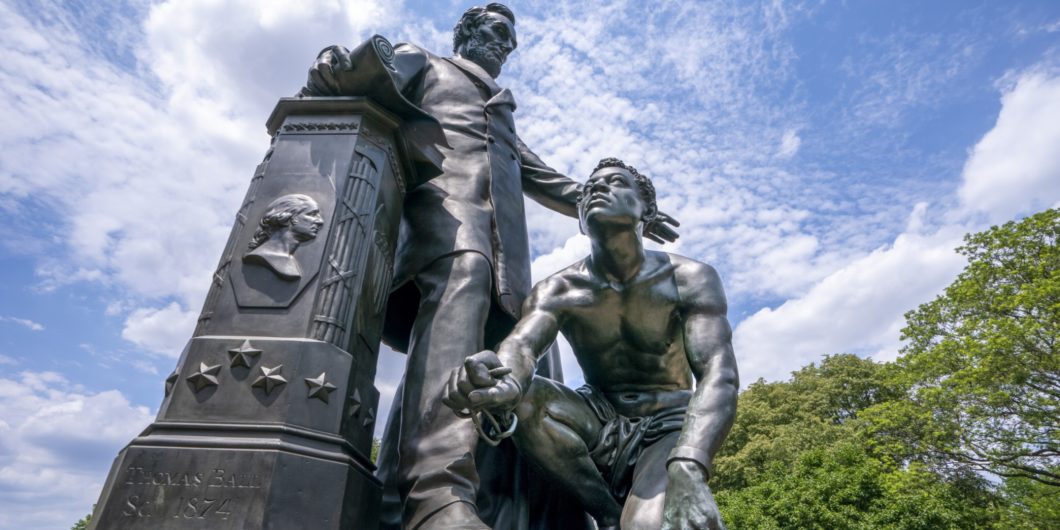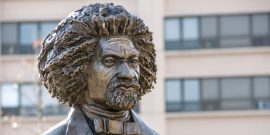Standing Up for Freedom
Protesters recently threatened to tear down the Emancipation Memorial, a statue of Abraham Lincoln and a former slave, Archer Alexander that stands in Washington, D.C.’s Lincoln Park. This commemoration was paid for by freed slaves, and Frederick Douglass delivered his “Oration in Memory of Abraham Lincoln” at its unveiling. Thankfully, their efforts were thwarted by police officers and everyday citizens.
The statue is controversial because Alexander is kneeling next to Lincoln. Some, like Representative Eleanor Holmes Norton, have called for the statue’s removal, because she believes the portrayal is demeaning. Douglass himself thought it was incomplete. Yet Douglass’ disagreement on design did not prevent him from offering his eloquent sentiments in support of the statue’s purpose.
And not all share Norton’s interpretation of the Emancipation Memorial. Marcia Cole, a member of the Female RE-Enactors of Distinction (FREED), an affiliate of the African American Civil War Museum, remarked that, “People tend to think of that figure as being servile but on second look you will see something different, perhaps. That man is not kneeling on two knees with his head bowed. He is in the act of getting up. And his head is up, not bowed, because he’s looking forward to a future of freedom.”
The statue shows the moment of liberation, rather than a state of subjugation. Alexander is strong and his face determined. His shackles have been rent, and he is poised like a runner at the starting gate. But rather than having both hands on the ground to steady himself, a single fist is clenched mid-air with resolve. This man knows only too well that he has been “kept down,” and that no one will be able to keep him there any longer.
The true significance of the memorial is what it symbolizes. It stands for the fulfillment of justice brought about by emancipation.
Indeed, it was common for abolitionist art to portray kneeling enslaved men in order to force the question, “am I not a man and a brother?” This compelled slave-owners to face their own hypocrisy. For a kneeling slave is not appealing to any alleged superior, but to a standard of justice. The depiction is an affirmation, not a rejection, of the principle “all men are created equal.”
The Emancipation Memorial provides such an example. Alexander is powerful not just for his physicality but because he has the force of right behind him. Where the memorial stands, citizens are free to gather and discuss these ideas and consider the statue’s meaning.
Protesters affiliated with “The Freedom Neighborhood,” however, have been intent on utilizing force, rather than the free exchange of ideas, to achieve their policy goals. They have declared that, “To achieve true justice, we are not working with the police, nor will we seek any relationship with them. In order to create change, we will do so by any means necessary. If you want a revolution, it won’t happen by being peaceful.” These individuals have no regard for the responsibilities of citizenship and are advocating for anarchy. And anarchy is a stepping stone towards tyranny. Such protesters are risking the destruction of this country and its principles, the country that once stood firmly against tyranny, as this statue reminds us.
For the true significance of the Emancipation Memorial is what it symbolizes. It stands for the fulfillment of justice brought about by emancipation. That deed was the accomplishment of countless men and women, many of whom gave their lives in the sacrifice of war as well as the “first martyr President of the United States.” Lincoln joins Alexander because, though Lincoln was sometimes forced to make compromises, he never lost sight of his objectives of preserving the Union and freeing the slaves.
As Frederick Douglass explained: “It mattered little to us what language he might employ on special occasions; it mattered little to us, when we fully knew him, whether he was swift or slow in his movements; it was enough for us that Abraham Lincoln was at the head of a great movement, and was in living and earnest sympathy with that movement, which, in the nature of things, must go on until slavery should be utterly and forever abolished in the United States.”
Douglass credited Lincoln with being the leader of the movement to end slavery. By calling for the destruction of the Emancipation Memorial, protesters stand in opposition, not solidarity, to that movement.
*A previous version of this essay misstated Douglass’ opinion on the statue.


